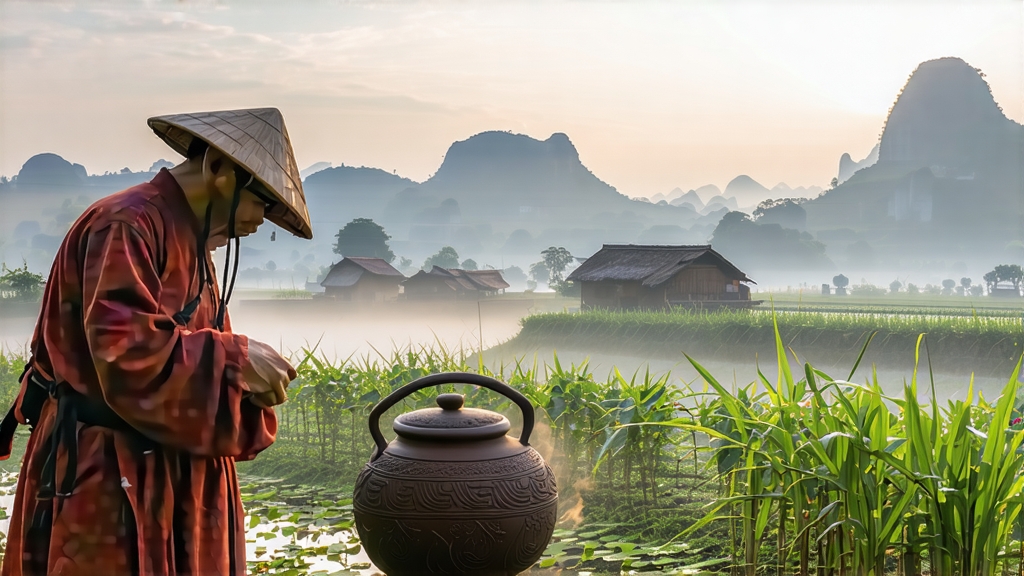
Liu Bao, literally “Six Forts,” is the quiet diplomat of China’s dark-tea family. While Pu-erh grabs headlines, this cousin from Guangxi province has spent four centuries crossing borders, calming stomachs, and sweetening with age. Its story begins in the dense, mineral-rich hills of Wuzhou, where the confluence of three rivers once funneled tea, rice, and medicinal herbs onto the ancient Tea Horse Road. Traders discovered that the compressed leaves not only survived the humid journey to Hong Kong and Southeast Asia but actually improved, trading rough edges for a syrupy depth that Cantonese tea houses still call “cooling gold.”
History first records Liu Bao in 1585, when a Ming garrison commander bartered pressed tea bricks for warhorses with highland chieftains. By the Qing dynasty the tea had become tribute, shipped in plaited bamboo baskets lined with banana leaf and stamped with the imperial dragon. The baskets—still the legal unit of sale today—allowed micro-oxidation during the month-long raft voyage down the Xun River, accidentally inventing the post-fermentation style later codified as “dark tea.” When the British opened Hong Kong’s port, Liu Bao sailed farther, filling the holds of clippers bound for Malaya where tin miners drank it to prevent beriberi. In 1950 the state-designated Wuzhou Tea Factory standardized the craft, yet every vintage still whispers of those river journeys: the musty sweetness of banana leaf, the camphor of ship holds, the salt of monsoon air.
Although officially one name, Liu Bao splinters into micro-categories defined by leaf grade, piling technique, and aging vessel. “Special Grade” uses only the first two leaves and a bud, yielding a bright, orchid-like aroma prized by Hong Kong collectors. “Third Grade” incorporates broader leaves and stems, developing a darker, taro-sweet liquor favored by Malaysian kopitiams. Craftsmen also speak of “upper basket” versus “lower basket”: the top layer, aerated during stacking, ferments more slowly, retaining a reddish amber color, while the bottom layer compresses under weight, emerging almost coffee-black. A rare 1980s “brick-basket” experiment pressed loose Liu Bao into 2 kg bricks before basket aging; the result marries the clarity of loose leaf with the earthy density of brick tea, a hybrid now auctioned in Macau for five figures.
Making Liu Bao is a dialogue between moisture, heat, and time. Plucked from late-April bushes growing at 300–500 m on lateritic red soil, the leaves are first withered under subtropical sun for three hours, softening cell walls for the kill-green wok. A 280 °C toss for eight minutes deactivates enzymes yet preserves surface microbes crucial for later fermentation. While still warm, the leaves are rolled for 25 minutes on bamboo trays, bruising tissue to release polyphenols. The signature step follows: wet piling. Workers heap 70 kg batches into 1.2 m mounds, spraying 20 % water by weight, then cover them with jute sacks and banana leaves. Internal temperature climbs to 55 °C within 36 hours; every 48 hours the pile is turned, aerated, and re-moistened. After 10–15 cycles the leaf turns walnut-brown, acquiring the scent of damp forest floor. Sun-drying reduces moisture to 12 %, after which the tea is steamed for three minutes, hand-packed into 50 kg bamboo baskets, and moved to aging rooms where humidity hovers at 75 %. There it will rest for at least three years, though connoisseurs chase three decades, during which slow oxidation and microbial action transmute bitter catechins into mellow theabrownins and rare gamma-aminobutyric acid, the compound credited with Liu Bao’s famous blood-pressure-lowering effect.
To brew Liu Bao is to steer a small voyage. Start with a 150 ml Yixing clay teapot seasoned only with dark teas; its double-porosity softens minerality. For every 100 ml use 5 g of leaf prised from the basket—never cut, always broken along natural fissures to respect cell integrity. Rinse with 95 °C water for five seconds, discarding the liquor while warming cups. The first proper infusion, 15 seconds at 98 °C, releases a garnet stream smelling of rain on hot basalt. Pour in a low arc